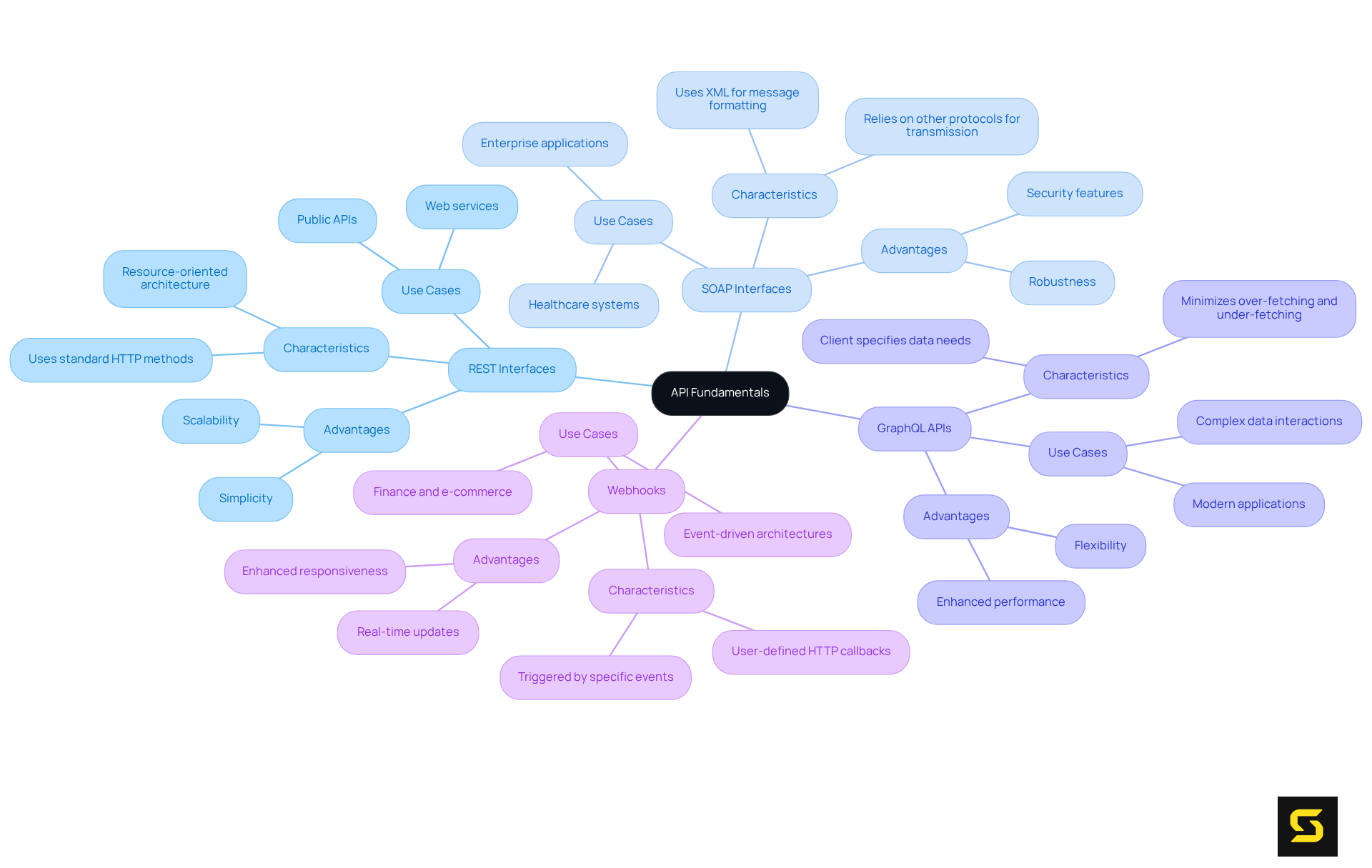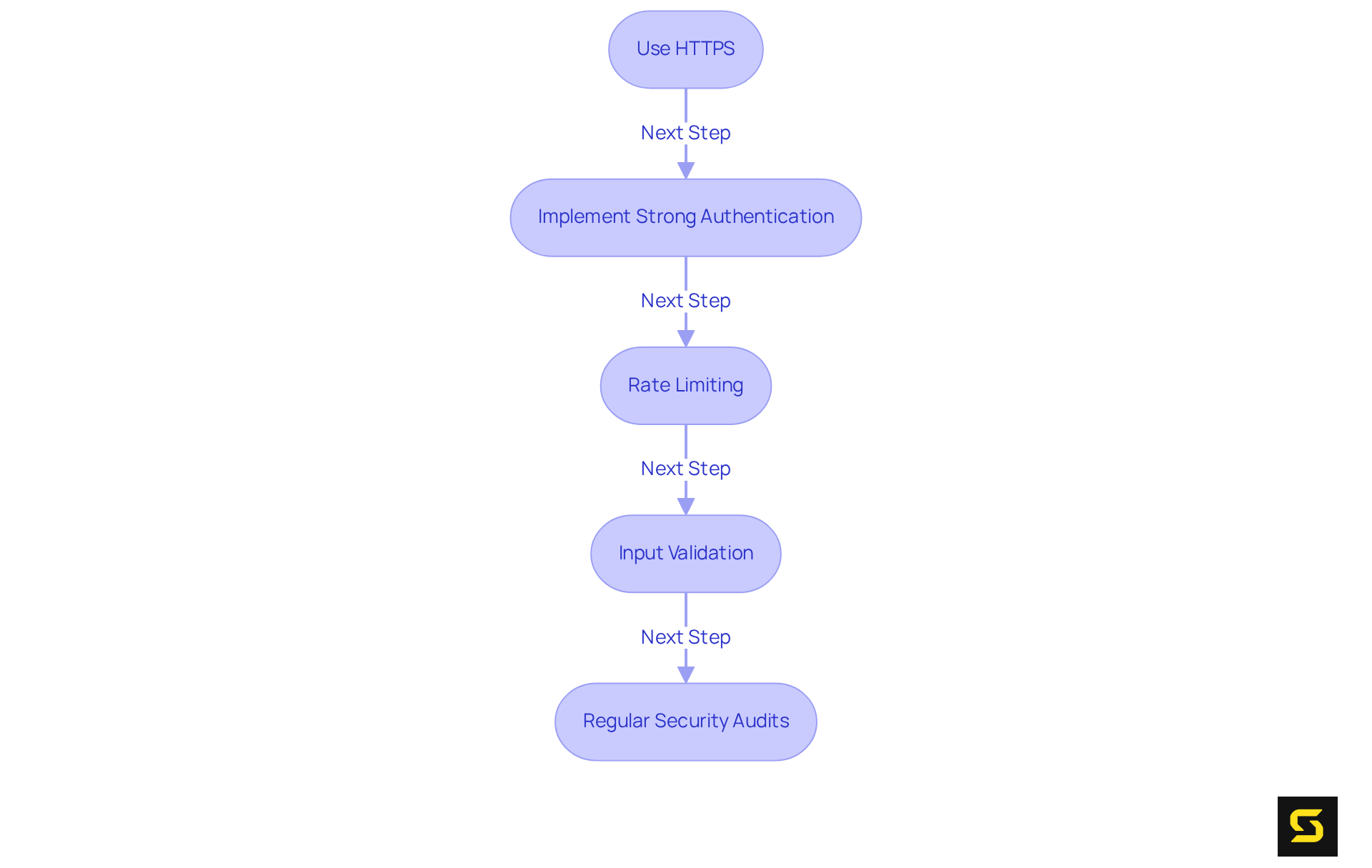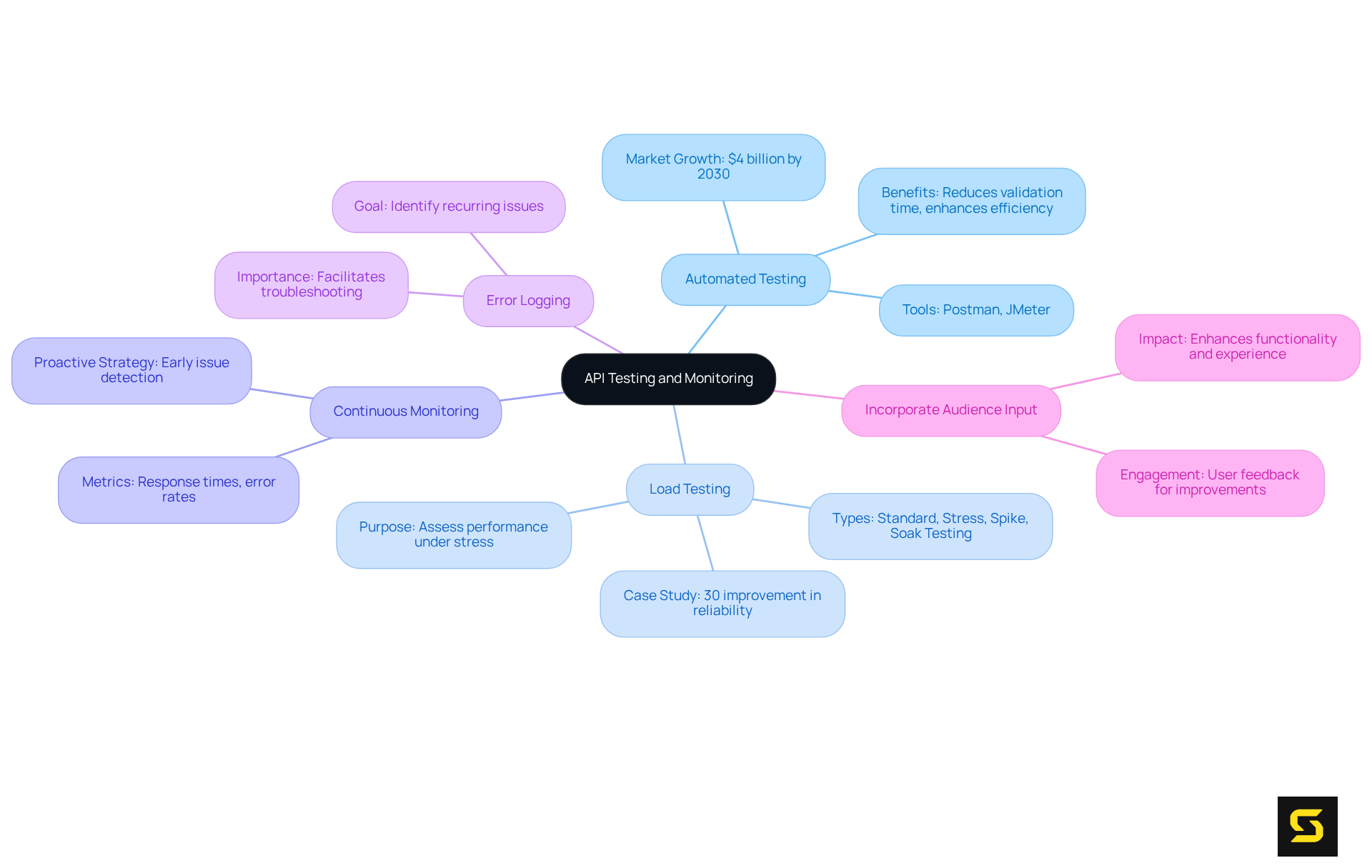Overview
This article outlines best practices for successful API development within the realm of Software as a Service (SaaS), underscoring the necessity of an API-first approach, stringent security measures, and thorough testing and monitoring. By defining interface contracts early, implementing HTTPS for security, and utilizing automated testing tools, organizations can significantly enhance collaboration, security, and reliability in API development.
These strategies are not merely recommendations; they are essential components that contribute to the overall success of SaaS offerings. Embracing these practices is imperative for any entity aiming to excel in the competitive landscape of SaaS.
Introduction
In the rapidly evolving landscape of software development, Application Programming Interfaces (APIs) serve as crucial conduits for enabling communication between diverse applications. Mastering the intricacies of API development is not merely a technical necessity; it represents a strategic advantage that can propel Software as a Service (SaaS) success.
As organizations increasingly adopt an API-first approach, the challenge lies in navigating best practices that ensure robust functionality, security, and efficiency.
How can developers harness the full potential of APIs while sidestepping common pitfalls in this dynamic environment?
Understand API Fundamentals and Types
Application Programming Interfaces (APIs) are essential intermediaries that facilitate seamless communication between diverse software applications. A solid understanding of the various types of APIs is crucial for effective software development, particularly in the context of API development and integration strategies.
-
REST Interfaces: The most prevalent type, REST interfaces utilize standard HTTP methods (GET, POST, PUT, DELETE) and are structured around resources. Their simplicity and scalability make them a preferred choice for developers.
-
SOAP Interfaces: This protocol employs XML for message formatting and relies on other application layer protocols for message negotiation and transmission. Recognized for their robustness and security features, SOAP interfaces are particularly suitable for enterprise-level applications, especially in sectors like healthcare where data integrity is paramount.
-
GraphQL APIs: A modern alternative, GraphQL allows clients to request only the specific data they need, effectively minimizing issues related to over-fetching and under-fetching. This flexibility enhances performance and user experience, particularly in applications requiring complex data interactions. The growing popularity of GraphQL underscores its effectiveness in meeting the demands of contemporary applications.
-
Webhooks: These user-defined HTTP callbacks are triggered by specific events within a web application, enabling real-time data updates and interactions. Increasingly utilized in event-driven architectures, particularly in finance and e-commerce, webhooks enhance responsiveness and client engagement.
Understanding these API fundamentals empowers teams to effectively align their API development strategies with business objectives and user needs. As we approach 2025, it is anticipated that over 60% of companies will adopt an API-first development approach, recognizing its benefits in fostering innovation and improving collaboration across teams. This trend underscores the importance of mastering API types and their applications in modern API development.

Adopt an API-First Development Approach
Implementing an API-first development approach necessitates several key steps:
-
Define Interface Contracts Early: Establishing clear specifications for your interfaces before any coding begins is crucial. This practice ensures that all stakeholders share a common understanding of the API development's functionality, which is essential for successful collaboration. As noted by industry experts, 'An API-first design institutionalizes a contract for API development to determine how your API will communicate with other programs.'
-
Enable Parallel Development: A well-defined API contract allows different teams to work on the frontend and backend simultaneously, significantly reducing development time. This parallelism in API development can result in an average time savings of up to 30% in project timelines, enabling faster market entry. In fact, over 80% of entities have implemented an API development program or strategy, highlighting the growing recognition of this approach.
-
Focus on Reusability: Designing APIs to be modular and reusable across various projects minimizes redundancy and lowers maintenance costs. This approach not only streamlines development but also enhances the overall efficiency of the software lifecycle. Case studies indicate that enterprises adopting an API-first methodology have experienced significant enhancements in their API development processes.
-
Documentation: Maintaining comprehensive documentation throughout the development process is vital. It facilitates easier onboarding for new team members and promotes better collaboration among existing teams, ensuring that everyone is aligned with the API's objectives and functionalities.
By following these steps, entities can cultivate a more efficient development atmosphere for API development that boosts productivity and propels innovation. However, it is essential to be aware of common pitfalls, such as inadequate stakeholder engagement or unclear specifications, which can undermine the effectiveness of the API-first approach. Industry leaders emphasize that defining API contracts early is not just a best practice but a strategic necessity in today's fast-paced tech landscape, especially for effective API development, where agility and responsiveness are paramount.

Implement Robust API Security Measures
To secure APIs effectively, organizations must adopt best practices that are essential in today’s digital landscape:
-
Use HTTPS: Encrypting data in transit is critical to protect against eavesdropping and man-in-the-middle attacks. By 2025, a significant percentage of organizations recognized this necessity, with many implementing HTTPS as a standard practice for API security. Notably, APIs now account for 71% of all web traffic, underscoring the urgent need for secure communication. As Anthony Dombrowski, Developer Relations, asserts, "Using HTTPS with TLS is non-negotiable for secure API communication."
-
Implement Strong Authentication: Utilizing OAuth 2.0 or JWT (JSON Web Tokens) is vital for secure access control. These protocols not only enhance security but also simplify identity management, significantly lowering the risk of unauthorized access. Real-world applications of these standards have demonstrated substantial advancements in managing identities and securing API development endpoints.
-
Rate Limiting: Protect application interfaces from misuse by establishing limits on the number of requests an individual can make within a designated timeframe. This measure is essential for preventing denial-of-service attacks and ensuring stable API performance.
-
Input Validation: All inputs must be validated to prevent injection attacks and other vulnerabilities. This practice is foundational in maintaining the integrity and security of interactions during API development.
-
Regular Security Audits: Conducting periodic reviews and testing of API security measures is crucial for identifying and addressing potential vulnerabilities. Organizations that prioritize regular audits are better equipped to adapt to evolving threats in API development. It is noteworthy that 58% of entities track their application interfaces less than daily, which can lead to insufficient security supervision.
By implementing these security measures, organizations can effectively safeguard their application interfaces against emerging threats, ensuring robust defense and preserving client trust. The anticipated outcomes include enhanced user trust and a diminished risk of breaches, aligning with the necessity for evolving security strategies.

Conduct Comprehensive API Testing and Monitoring
To ensure APIs function as intended, organizations must implement effective testing and monitoring strategies that command attention and drive results:
-
Automated Testing: Leverage tools such as Postman and JMeter to automate both functional and performance testing. This approach guarantees that application interfaces operate as anticipated under various conditions, significantly reducing validation time and enhancing overall efficiency. The global API development market is projected to reach $4 billion by 2030, underscoring the escalating importance of these practices in the industry.
-
Load Testing: Simulating high-traffic scenarios is crucial for assessing API performance under stress. This testing is essential for identifying potential bottlenecks and ensuring that APIs can manage peak loads, which is vital for maintaining customer satisfaction during high-demand periods. For instance, a UK-based cloud services provider achieved a 30% improvement in system reliability through automated API development testing, demonstrating the effectiveness of these practices.
-
Continuous Monitoring: Employ monitoring tools to track API performance metrics in real-time, including response times and error rates. This proactive strategy empowers organizations to detect issues early, reducing latency and enhancing user experience. As emphasized by CTOs and developers, proactive testing is non-negotiable for maintaining reliability in API development.
-
Error Logging: Maintaining comprehensive logs of API errors is critical for facilitating troubleshooting and informing future iterations. Effective error logging is indispensable for identifying recurring issues and enhancing API reliability.
-
Incorporate Audience Input: Engaging users in the testing process is key to identifying areas for improvement. This involvement not only enhances the API's functionality but also contributes to a superior overall experience. As Anna Irwin observed, "Slow or unreliable interfaces can lead to a poor experience for individuals, impacting customer satisfaction and retention."
By conducting extensive testing and monitoring, companies can ensure their API development processes result in dependable and effective interfaces, ultimately supporting SaaS success. The stakes are high; poorly performing APIs can result in slow applications, frustrated users, and lost revenue, making these practices essential for any entity aiming to thrive in the competitive SaaS landscape. Moreover, organizations must remain vigilant about the potential pitfalls of both over-testing and under-testing, as either can lead to resource strain or overlooked vulnerabilities.

Conclusion
Mastering API development is essential for achieving success in the SaaS landscape. By comprehensively understanding the various types of APIs and adopting an API-first development approach, organizations can drive innovation, enhance collaboration, and streamline their development processes. This strategic focus not only aligns with business objectives but also addresses the evolving needs of users.
Key insights from the article underscore the importance of:
- Defining interface contracts early
- Enabling parallel development
- Prioritizing robust security measures
Implementing practices such as:
- Automated testing
- Continuous monitoring
- Engaging user feedback
is critical for ensuring that APIs function effectively and meet performance expectations. Collectively, these strategies contribute to building reliable and efficient APIs that enhance user satisfaction and organizational success.
As the demand for APIs continues to escalate, organizations must remain proactive in their development and security practices. Embracing an API-first approach, coupled with comprehensive testing and monitoring strategies, will not only safeguard against vulnerabilities but also position entities to excel in a competitive market. The future of API development is promising, and those who master these best practices will undoubtedly lead the way in delivering exceptional software solutions.
Frequently Asked Questions
What are APIs and why are they important?
APIs, or Application Programming Interfaces, are essential intermediaries that facilitate seamless communication between diverse software applications. They are crucial for effective software development, particularly in API development and integration strategies.
What are the different types of APIs mentioned in the article?
The article mentions four types of APIs: REST Interfaces, SOAP Interfaces, GraphQL APIs, and Webhooks.
What are REST Interfaces and why are they popular?
REST Interfaces are the most prevalent type of API that utilize standard HTTP methods (GET, POST, PUT, DELETE) and are structured around resources. Their simplicity and scalability make them a preferred choice for developers.
How do SOAP Interfaces function and where are they typically used?
SOAP Interfaces use XML for message formatting and rely on other application layer protocols for message negotiation and transmission. They are recognized for their robustness and security features, making them suitable for enterprise-level applications, particularly in sectors like healthcare where data integrity is essential.
What is GraphQL and what advantages does it offer?
GraphQL is a modern API alternative that allows clients to request only the specific data they need, minimizing issues related to over-fetching and under-fetching. This flexibility enhances performance and user experience, especially in applications requiring complex data interactions.
What are Webhooks and how are they utilized?
Webhooks are user-defined HTTP callbacks triggered by specific events within a web application, enabling real-time data updates and interactions. They are increasingly utilized in event-driven architectures, particularly in finance and e-commerce, to enhance responsiveness and client engagement.
Why is understanding API fundamentals important for teams?
Understanding API fundamentals empowers teams to effectively align their API development strategies with business objectives and user needs, fostering innovation and improving collaboration across teams.
What is the anticipated trend regarding API development by 2025?
By 2025, it is anticipated that over 60% of companies will adopt an API-first development approach, recognizing its benefits in fostering innovation and improving collaboration across teams.





